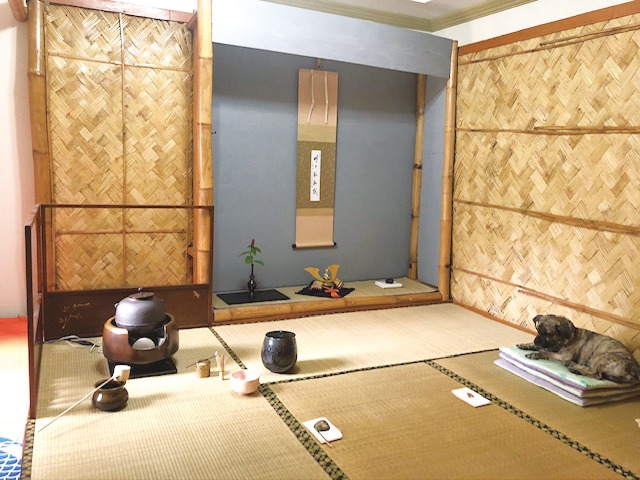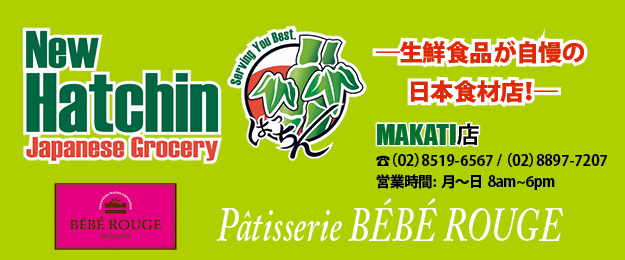
アリス・ンさん Ms. Alice Ng (写真右) 香港出身。来比6年、マカティ市在住。「コロナ禍の前は裏千家マニラでの定期的なお稽古をしていたのですが、家では充分とはいえませんでした。皮肉なもので、コミュニティ防疫で在宅の時間が長くなり、茶道の勉強時間を確保できるようになりました」。 Ms. Alice Ng (right)from Hong Kong has been living in Makati City for six years. ‘Before the pandemic as a laggard student, I had regular Okeiko practices at Urasenke Manila, not often enough at home. Ironically due to the ECQ, I spend more time at home and am able to practice tea ceremony procedures at home.’ (写真)3月、釣り釜の季節にKyoko Tyさん(左)が亭主として正客の舘野さん(中央奥)、末客のアリスさん(右)をもてなした。In March, this year’s hanging kettle season, Ms. Kyoko Ty (left)as the host prepared the tea for Ms. Tateno(center), a principal guest and an accompanying guest Ms. Alice Ng. (right)
わびさびの精神に惹かれ 茶道の心得を学ぶ日々
夫に帯同してマニラに来てから、日本文化としての茶道をより深く理解すると同時に、茶道は私にとってかけがえのない趣味となりました。
日本の茶道に初めて出会ったのは2014年、台湾・台北市の東吳大學での特別講座。多文化の影響と、わびさびの精神に強く惹(ひ)かれたのです。
コロナ禍で在宅時間が長くなったことで、いろいろな点前(てまえ、お茶をたてること)を練習したり、茶の湯の歴史を勉強したりする時間が増えました。コンドミニアムのユニットに設けた茶室でひとり思いのままに茶道を楽しんでいますが、本来茶道は招く者と客の一体感、「一座建立」(いちざこんりゅう)をめざすもの。招く者としては、心身ともに清らかに、いかなることもおろそかにしないことを心がけます。また、客としてはおもてなしを喜び、感謝します。
茶室では、和敬清寂(わけいせいじゃく)の心得を意識しています。茶道を通じてめざすのは、このような精神、心得を普段の暮らしの中にも生かすことでしょうか。

アリスさんの茶室「寂廬 じゃくのいおり」 。畳は台湾、いろりなどは日本のものを使用し、タガイタイのニッパヤシと竹でできたフィリピン伝統の小屋「Kubo Hut」をイメージしてフィリピン人の大工が施工。 The tearoom in Ms. Alice Ng’s condominium unit ‘Jyaku no Iori,Sans Souci’ The Tatami mats were brought from Taiwan and some utensils like the sunken hearth and tearoom nails were from Japan. Inspired by Kubo huts in Tagaytay, the structure was built by Filipino carpenters.
Charmed by Wabi-Sabi, Learn the Spirit of Tea Ceremony
Since coming to Manila as a dependent with my husband, tea ceremony has been a priceless pastime for me to continue the pursuit of a better understanding of this Japanese culture.
The first time I experienced Japanese tea ceremony was in an extra curriculum Chado course at Soochow University,Taipei City, Taiwan in 2014. I was fascinated by its multi-cultural influences and wabi-sabi principles of tea ceremony.

茶道具。手前左からフィリピン人の陶芸家Joey de Castro制作の茶碗、茶筅(ちゃせん)、中央奥に水差し、手前右に棗(なつめ)。 Tea Ceremony Utensils : ( left ) Tea bowl made by Filipino potter Joey de Castro; tea whisk Chasen, tea scoop Chashaku (Center), freshwater vessel Mizusashi , (right) thin tea powder container Natsume
Since the pandemic hit, I spent more time at home practicing various Temae (preparing tea) tea ceremony procedures. Moreover, it gave me the opportunity to study other aspects like history and logic of Chanoyu which added to my understanding of the culture.
In the tearoom built in my condominium unit, I enjoy practicing alone when I can set my own pace. However, tea Ceremony is basically a communal creative activity and the concept of Ichizakonryu to build together as one is best played out with tea companions when there are interactions between each role. As a host, curiously the first thing which comes to my mind is proper preparation. Starting point is cleaning physically and spiritually then to result in not omitting a single thing. As a guest, it is the heartfelt joy and appreciation of the hospitality Omotenashi. When in the tearoom, I am aware of the principles of Wa-Kei-Sei-Jaku.
I think my goal as a tea ceremony enthusiast is to blend the principles and spirits of tea ceremony with everyday life.

春の茶菓子 「 藤」と萩焼の菓子皿(菓子、皿ともにKyoko Tyさん作) Spring tea sweet “Wisteria” Okashi “Fuji” made by Ms. Kyoko. The house sweet plate Kashizara, a Hagi ware, is also made by Ms. Kyoko Ty.
Photos courtesy of Ms. Alice Ng















